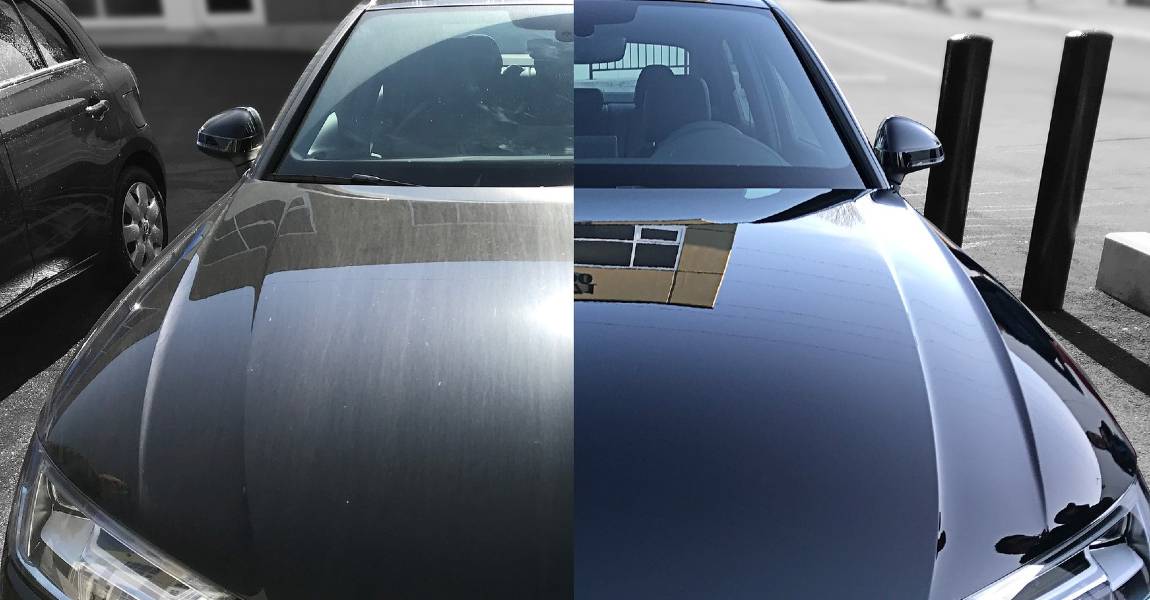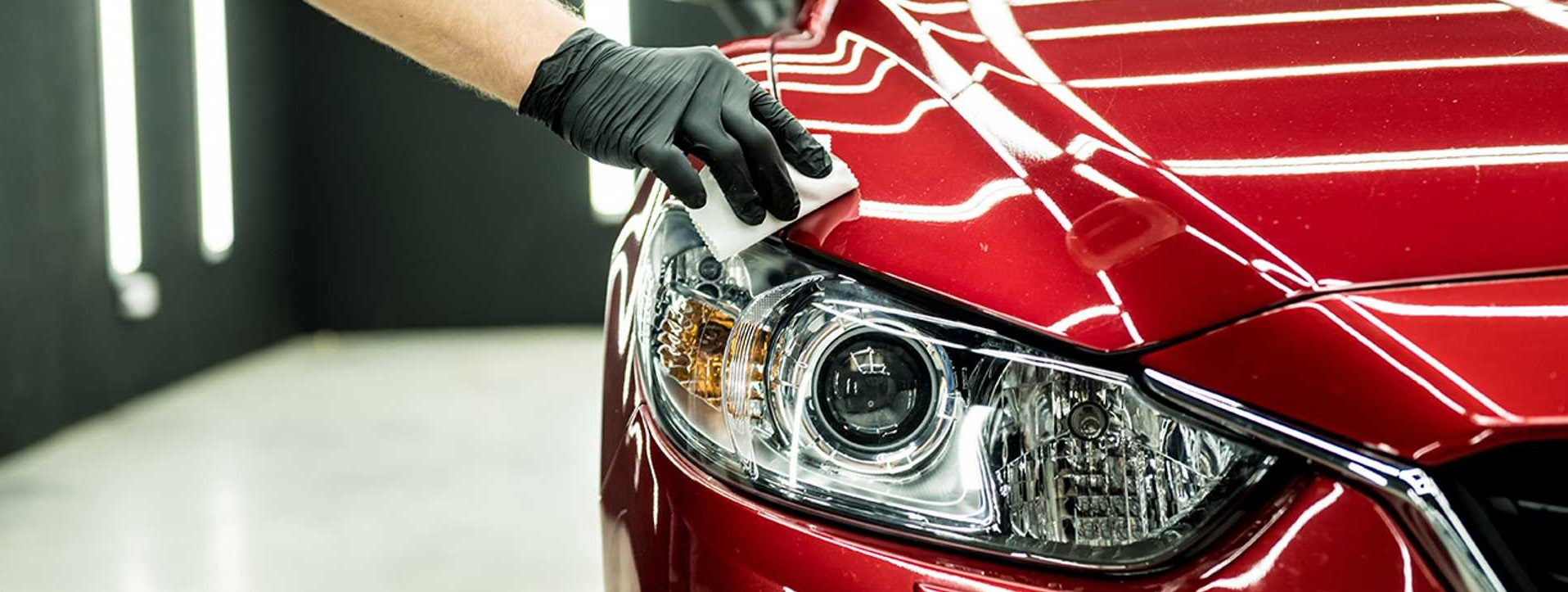Ways Ceramic Coating Newark saves you money over time
Wiki Article
Discovering the Scientific Research Behind Car Ceramic Coating and Its Safety Properties
The scientific research of car ceramic coating provides an interesting research study in innovative vehicle protection. Made up mostly of silicon dioxide and polymers, these coatings develop a durable bond with lorry paint. This communication boosts durability versus ecological threats while providing hydrophobic advantages. However, the ins and outs of how these layers work and their long-term benefits stay much less understood. Unloading these information exposes why ceramic finishes are becoming a preferred choice for car careWhat Is Ceramic Coating?
Ceramic coating is a fluid polymer that chemically bonds to the surface of a lorry's paint. This advanced protective layer boosts toughness and supplies exceptional resistance to ecological aspects. Unlike conventional wax or sealers, which provide short-lived defense, ceramic coverings create a long-lasting shield that can stand up to rough conditions such as UV rays, acidic pollutants, and severe climate. When applied correctly, the coating develops a hydrophobic surface area, creating water to bead and slide off, which assists in maintaining the vehicle's tidiness. Additionally, it offers boosted gloss and deepness to the paint, making the lorry show up even more polished and vivid. The application procedure typically entails detailed surface prep work, including cleansing and polishing, to assure peak bonding. As a result, ceramic coverings are ending up being increasingly prominent among car enthusiasts and those seeking to protect their investments, guaranteeing to preserve the vehicle's aesthetic allure while reducing the frequency of maintenance.The Make-up of Ceramic Coatings
The elaborate formula of ceramic coatings mainly includes silicon dioxide (SiO2), which is stemmed from natural resources like quartz and sand. This essential part gives the foundation for the coating's sturdiness and protective high qualities. Along with SiO2, ceramic finishings usually include various polymers and additives that improve attachment, versatility, and resistance to ecological elements. These substances work synergistically to produce a durable obstacle versus contaminants such as dirt, chemicals, and UV rays.Furthermore, some solutions integrate titanium dioxide (TiO2) or various other nanomaterials, which can augment the coating's hydrophobic residential properties, leading to improved water repellency. The accurate structure can differ significantly among manufacturers, affecting efficiency and longevity. Eventually, the mix of these components culminates in a protective layer that not just enhances the aesthetic appeal of automobiles however additionally offers to extend their lifespan by securing the surface area from prospective damage.Exactly How Ceramic Coatings Work
Understanding exactly how ceramic coatings function involves discovering their chemical make-up, which adds to their safety high qualities. The application process is important for accomplishing perfect outcomes, while long life and sturdiness aspects identify the coating's efficiency gradually. With each other, these components highlight the advantages and performance of ceramic layers for vehicle security.Chemical Structure Explained
While many car proprietors look for resilient security for their vehicles, the chemical composition of ceramic finishes plays a vital duty in their performance. These coatings mainly include silicon dioxide (SiO2), which is stemmed from natural minerals. This substance forms a strong bond with the automobile's paint, producing a sturdy, safety layer. Additionally, several ceramic coatings consist of titanium dioxide (TiO2), improving their hydrophobic residential or commercial properties and resistance to UV rays. The presence of polysiloxanes can even more enhance versatility and durability. Together, these aspects add to the coating's capacity to repel water, dirt, and pollutants, while additionally supplying a high-gloss coating. Recognizing this chemical structure aids car proprietors value the robust defense used by ceramic finishings.Application Refine Review
Applying ceramic layers involves a meticulous procedure that assures optimal bonding and security for the car's surface area. At first, comprehensive cleaning and purification of the car's outside are executed to eliminate dirt, grime, and previous waxes. This action verifies that the surface is without impurities that can hinder adhesion. Following this, the paint is frequently brightened to improve clarity and get rid of any type of blemishes. As soon as prepared, the ceramic coating is used in little areas using an applicator pad, permitting uniform coverage. The coating is after that entrusted to heal, forming a strong chemical bond with the surface. Appropriate curing times and problems are vital, as they verify the coating attains its maximum efficiency and safety qualities.Longevity and Sturdiness Elements
Ceramic finishes are made to supply resilient protection through their innovative chemical make-up, which develops a durable obstacle against ecological contaminants. The toughness of these layers is affected by factors such as the thickness of the application, the high quality of the item, and the conditions under which the automobile is exposed. High-quality ceramic finishes can last several years, standing up to scrapes, UV rays, and chemical stains. Appropriate upkeep, including routine washing and routine reapplication, can better improve durability. Additionally, ecological factors like climate and direct exposure to contaminants can affect the life-span of the coating. In general, when used and maintained correctly, ceramic layers offer extraordinary toughness, YOURURL.com making them a prominent option for car enthusiasts looking for to protect their lorry's look.Hydrophobic Characteristics and Water Repellency
Hydrophobic residential or commercial properties are a characteristic of quality car ceramic layers, considerably boosting the automobile's surface efficiency. These finishes produce a molecular bond with the car's paint, resulting in a surface area that repels water successfully. When water comes into call with a ceramic-coated surface area, it beads up and rolls off, lessening the quantity of fluid that continues to be on the paint. This actions not just adds to an aesthetically pleasing appearance yet likewise minimizes the buildup of contaminants such as dust, crud, and roadway salts.The enhanced water repellency results in easier cleaning and maintenance, as less effort is required to get rid of undesirable substances. Furthermore, the hydrophobic nature of ceramic coverings aids in preventing water spots, which can mar the coating of uncoated surfaces. Overall, the consolidation of hydrophobic residential or commercial properties in ceramic finishings plays an essential function in preserving the car's pristine look while streamlining maintenance.Defense Against Scratches and UV Damages
Car ceramic finishes use significant protection versus scratches and UV damage. The scrape resistance mechanism produces a long lasting layer that absorbs influences, while the UV securing benefits aid preserve the vehicle's paint integrity with time. Together, these attributes add to a longer-lasting and visually enticing surface.Damage Resistance Mechanism
Making use of advanced modern technology, ceramic layers supply a robust shield versus scratches and UV damage, enhancing the durability and appearance of automobile surfaces. The scrape resistance system of these finishes is connected to their distinct molecular framework, which creates a durable bond with the car's paint. This bond creates a hard, safety layer that can soak up effects and stand up to abrasions. Furthermore, the smooth surface area of the coating reduces friction, making it hard for pollutants to adhere and trigger scratches. The chemical make-up of ceramic finishes frequently consists of nanoparticles that enhance the safety layer, further boosting its durability. Consequently, cars treated with ceramic finishings exhibit substantially boosted scrape resistance compared to typical wax or sealants, making certain an immaculate coating with time.UV Shielding Perks
The safety top qualities of ceramic coatings extend past scratch resistance to consist of significant UV shielding advantages. These coverings develop a durable obstacle that mirrors hazardous ultraviolet rays, protecting the car's paint and underlying products. Long term direct exposure to UV radiation can cause fading, oxidation, and wear and tear of the paint coating. By including ceramic layers, car proprietors can efficiently minimize these threats, protecting the visual charm and stability of their cars and trucks. Furthermore, the UV blocking homes add to improved long life, lowering the frequency of painting and upkeep. Inevitably, the combination of ceramic coverings uses a complete remedy for shielding vehicles from the damaging results find out here of sun exposure, making certain a sustained, lively appearance in time.The Longevity and Maintenance of Ceramic Coatings

Regularly Asked Questions
Can Ceramic Coating Be Applied to Any Kind Of Sort Of Automobile?
Ceramic coating can be related to different kinds of lorries, including cars, vehicles, and bikes. Nevertheless, surface prep work and compatibility with details materials are vital for ideal attachment and effectiveness of the coating.How Much Does Ceramic Coating Typically Expense?
Ceramic coating generally sets you back in between $500 and $2,000, relying on factors such as lorry dimension, coating top quality, and professional application. The investment can give lasting security and boost the car's appearance with time.
Is Professional Application Required for Best Outcomes?
The requirement of specialist application often depends upon desired outcomes. Experts commonly ensure proper surface preparation and application strategies, causing excellent bonding and longevity of the coating, which might be challenging for inexperienced people to attain.Can Porcelain Coatings Be Gotten Rid Of or Repaired?
Ceramic coatings can be eliminated or fixed, though the process might need particular solvents or strategies - Ceramic Coating Newark. Correct elimination is important to prevent damage to the underlying surface area, highlighting the value of professional help for excellent resultsHow Does Porcelain Coating Compare to Standard Wax?
The comparison in between ceramic coating and conventional wax exposes that ceramic finishings use superior durability, boosted security against ecological pollutants, and longer-lasting luster, while wax needs much more constant application and provides less overall resistance to damage.Report this wiki page